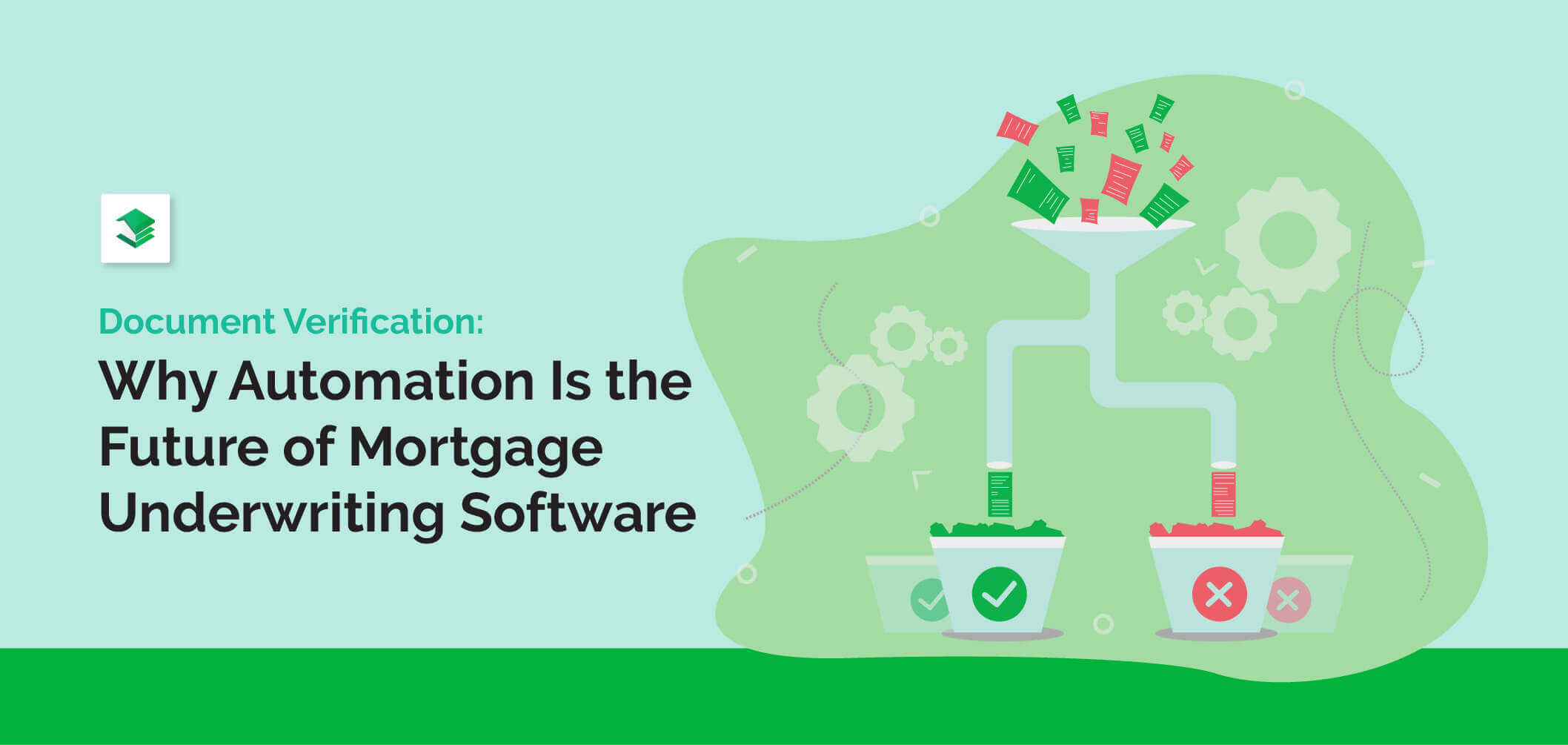The mortgage industry continues to grow as more and more Canadians are looking to purchase homes. But despite this rapid growth, the mortgage industry is still lagging and is slow to adopt new technologies like automated underwriting software.
One area that is a major pain point in the mortgage industry is document verification. This essential process is often the first touchpoint for customers and their mortgage specialist. And checking documentation is an important yet daunting task. A mortgage specialist must collect a variety of documents, assess them, and verify the identity, credibility, and capability of an individual.
The smallest mistake can lead to compliance problems, poor funding decisions, and much more. With so much riding on document verification, why has the mortgage industry taken so long to adopt cutting edge technologies like automated document verification?

What Documents Are Typically Required for a Mortgage?
Whether a borrower goes through a mortgage broker, their bank, or a private lender—each of these avenues requires extensive research into the quality of a borrower.
The document verification process is the initial step that gets the entire process rolling. Here’s a brief snapshot of what documents are typically required:
- Current assets and liabilities
- Current and previous employment history
- Credit reports
- Income verification
- T1 slips
- Payslips
- Investment statements
- A copy of the real estate listing a borrower is looking at
- Complete property information
- Credit history search consent
- Banking information
- … and many others.
Depending on how a borrower looks, a lender may ask for even more. For self-employed individuals, the process is even more complicated. If documents are submitted improperly, this process can span several days to weeks.

Why Is Document Verification Important?
Lenders are taking on risk every time they issue a loan, so they utilize an approval process to find suitable candidates that have the capacity to repay. The document verification step allows lending companies to find trustworthy borrowers by verifying their credit, capacity, collateral, character, and capital.
A candidate’s documentation gives insight into his assets, capital, work history, credit report, and current loans. All of this information contributes to how trustworthy the borrower is.
More important, financial institutions and the government have mortgage compliance regulations in place to prevent fraud. Identity theft, for instance, is a notorious practice lenders search for through documentation.
The Ontario government has published a reference webpage about mortgage fraud, defining the crime, and suggesting methods to recognize and avoid it. Notice that fabricating or leaving out paperwork is one of the top recommendations, reinforcing the importance of document verification.
But how do you ensure that this process is completed accurately and effectively?
How Document Verification Works Today
The traditional method lenders use to check a potential candidate is to ask the borrower to send them all the required documentation. From there, an employee at the mortgage company will carefully look through the details of the file and do their due diligence.
This method is not only slow, tedious, and costly—but also susceptible to human error. Because every potential borrower provides documents like these, lenders are always searching for ways to collect and verify these records more efficiently without compromising accuracy.

What Technologies Are Available Today?
Many digital services like AWS Textract, Microsoft Azure Search, and Tesseract are pushing for more effective data extraction technologies that the mortgage industry should be interested in. These technologies not only improve accuracy, but they also expedite information extraction.
AWS Textract
One of Amazon’s many web services, Textract is an optical character recognition (OCR) software. It converts raw scanned documents into searchable text and data. It’s also capable of processing tables and handwritten fields in forms.
Textract is much faster and accurate than manual data entry and doesn’t require code maintenance. Amazon’s official site even advertises maintaining compliance in document archives as a potential use case.
Microsoft Azure Search
Microsoft’s Cloud service Azure uses artificial intelligence technology to transform raw scans into searchable content. Specifically, it searches for various attributes such as:
- The language of the document
- Any people or organizations mentioned in the text
- Locations
- Images and what they represent
- Key phrases
Azure is customizable too, allowing companies to configure it towards their industries’ requirements.
Tesseract
Considered one of the best open-source OCR engines, Tesseract is free software that’s sponsored by Google. With support for multiple languages, it’s one of the more accessible services for data extraction.
However, it’s also primarily intended for backend use. Tesseract runs from the command line entirely, and users must prepare input images properly to generate an ideal output. For example, the scans must not have borders and be the right size.
How Fundmore Has Enhanced The Document Verification Process
As useful as these services are, they are still only general text extraction programs. The job of finding and analyzing the data related to the mortgage industry is still up to the user.
Integrate It With Anything
Fundmore has a solution tailored precisely toward mortgage lenders. We use machine learning and artificial intelligence to automate the process, acquiring data through API integration whenever necessary.
This means that you can guarantee that the documents Fundmore analyzes are accurate, reducing your risk and streamlining your entire underwriting process.
Fundmore Is Continuously Learning
Our learning network is continually improving itself to reduce the number of errors during document verification; when it notices a common discrepancy, it will remember and begin searching for the mistake in the future. This way, loan companies can check for errors and prevent fraud more consistently.
Waste Less Time and Money Working on Files
Under traditional methods, the mortgage industry spends tremendous amounts of time, money, and energy to analyze every possible borrower, only a portion of whom end up eligible for the loan. Mortgage businesses can cut down massively on operating costs by switching to Fundmore.
This means you can analyze more files, approve them quicker, and improve the customer experience by expediting the entire process.
Reliably Reduce Human Error
Real estate transactions are large by nature, and mortgage files are complex. With so many moving pieces, it’s not uncommon for mistakes to be made. Fundmore leverages machine learning to eliminate human error, freeing up your team members to focus on other areas of your business.
The Future of Mortgages Is An Automated One
Innovative fintech companies are continuing to push the boundaries of the mortgage industry. While large financial institutions are slow to adapt to these changes, they are investing heavily in them.
In the digital age, companies must deliver exceptional consumer experiences through every stage of the process. Mortgage brokers cannot sit idly anymore, relying on outdated systems to sustain their business. They must leverage cutting edge technologies to improve their operational efficiency from top to bottom.
Automation is already impacting the mortgage industry, and it’s only a matter of time before machine learning revolutionizes the way mortgages are assessed, approved, and funded.
